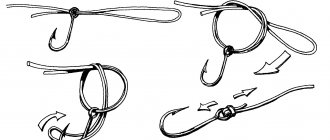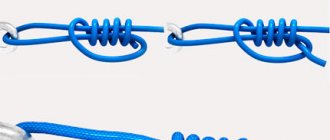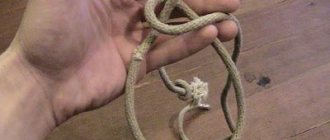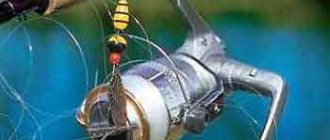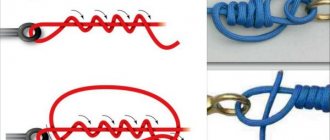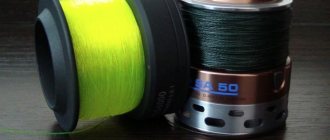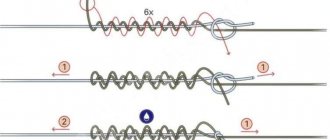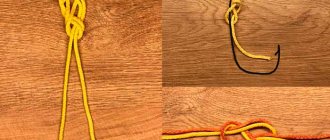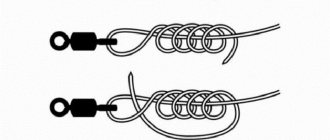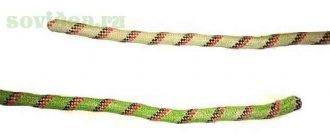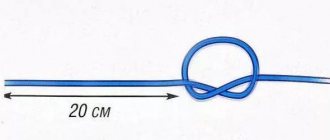To catch fish, you need to be well prepared. You need to use the appropriate gear and only those knots that will not fail you at the most inopportune moment. It will be difficult for a fisherman to accept the fact that a trophy fish fell off the hook due to a poorly tied knot.
The Palomar knot is one of the most commonly used knots and has earned a reliable reputation over a long period of use. Having learned how to knit it correctly and use it in various situations, the fisherman can be confident in the reliability of the connection.
Palomar - what kind of node is this, its purpose
This knot is widely used in spinning practice, a little less often among donkers and feeders. It practically does not reduce the strength of the gear. The ease of tying and efficiency allow it to be used by both beginners and experienced fishermen. To knit it, approximately 15 cm of fishing line is required. If you plan to use Palomar, this must be taken into account when determining its length.
Knotting is used for various purposes, including tying hooks, swivels, spinners, and more. Depending on the application, various modifications of the unit can be used. The most common options will be discussed next.
In most situations, Palomar is used to tie a hook, as well as fittings for subsequent attachment of a bait or leash. In some cases it is used to attach sinkers.
Classic palomar for attaching a swivel, fastener, spinning bait directly
How to tie a classic palomar knot
In the classic version, Palomar is used for braided lines, but it can also be used for other types of fishing lines. In some cases, if necessary, changes can be made to the order of knitting the knot.
Connection for braid
This method of creating a node is considered classic. To tie this knot using braid, you will need to perform the following steps:
- To tie the hook, you need to fold the end of the cord in half.
- The double line must be passed through the eye.
- You need to tie a simple knot so that the eye of the hook is inside the knot. You cannot tighten it at this stage.
- The double end of the cord is threaded through the loop.
- A hook is threaded through the resulting loop.
- Now you need to tighten the knot.
The procedure for creating a node can be seen in the figure:
Palomar for braid
Use for monofilament and fluorocarbon
These types of knot connections are usually more subtle. Folded in half, they fit well even into a miniature ear. In contrast, double braid may not fit the hole. In the latter situation, you will have to use other nodes.
The palomar knot can be used for fluorocarbon when knitting hooks and fittings
For a drop shot
In this case, a modification of the Palomar node is used. This is due to the peculiarities of using such equipment. Knitting a knot occurs as follows:
- A double fishing line is threaded through the hole.
- Make a simple knot.
- The line is passed through it once.
- Pass the hook through the double thread.
- After this, a single line is threaded through the eye of the hook.
In this way, the hook is tied in such a way that it is attached directly to the main line along its length. Details of the procedure for tying a palomar angle for a drop shot rig are shown in the diagram below:
Drop shot rig on palomar knot
As a result of tying the knot, the hook should be oriented with its point up and parallel to the fishing line.
Palomar Unit Specifications
One of the most reliable installations, which maximizes the strength of the fishing line, is the palomar knot. It is recommended to be used not only by respected sports fishermen, but also by manufacturers of fishing lines, braids, artificial baits, etc. Why did fishing enthusiasts love this installation?
- Initially, this type of connection was intended for monofilament threads. However, in practice, many spinning anglers and feeder fans use it to tie baits and equipment to braided cords.
- The use of a palomar knot allows you to maintain the strength of the fishing line up to 80% of its original state.
- The installation is suitable for reliable fastening of hooks, spinners, flies, and various equipment with fishing line of different thicknesses.
- The popularity of palomar has led to the emergence of many modifications. Some anglers, when tying a hook, do not even realize that they are very familiar with palomar.
- An important advantage of this knot is its ease of knitting. Any beginner can easily master several simple movements and techniques.
Double palomar
The use of double Palomar increases the strength and reliability of the unit. Its knitting is done as follows:
- The end of the fishing line is folded in half.
- Thread it through the eye of the hook.
- Create a simple loop so that the eye of the hook remains inside it.
- The tip that comes out of the loop is passed through it one to three more times.
- The noose is not yet tightened. The hook is threaded through the double end.
- The line is moved closer to the knot, and after that they begin to tighten. It is important that the loop is such that the fishing line passes freely through the eye.
You can clarify how double Palomar binds by studying the following diagram:
Double palomar, but it can be triple or quadruple
It is important to note that despite the name of the knot, the tip can be threaded through the knot two to four times.
Palomar node. Palomar fishing knot: features and methods of tying
Many fishermen dream of catching a big fish, but they need to prepare in advance for the hunt for a trophy. And it will be extremely disappointing if the trophy goes away due to an untied knot. Therefore, you need to learn how to knit correctly. Today our object will be the palomar fishing knot, which is used by anglers to tie a leash, baits and hooks to a fishing line. Let's talk in more detail about knitting techniques and look at the knot pattern.
Content
How to knit
Although the palomar knot is used for mounting various fishing accessories, we will consider the scheme for tying it using the example of a swivel. I think this will be much better and clearer for beginners and experienced fishermen.
The knot is tied on a double fishing line, so when you leave the free end of the fishing line you need to correctly calculate the length and leave a reserve of fishing line or braid
. Leave the working end with the expectation that one knot will require approximately 15 centimeters of fishing line.
Measure about 15 centimeters from the working end of the fishing line and fold it in half. Now you need to insert the double end through the eye of the swivel (bait, cable or hook), as in the diagram below.
The disadvantage of such a knot is that it will be difficult to thread the double end through a thin eyelet. If this is the case, you can try pulling the single end through the eyelet and then pulling it back through. Ultimately, you should achieve the same result.
Now tie a classic single knot in such a way that the swivel can move inside it, as shown in the picture below.
Now comes the hard part. You need to pull out the double end so that you do not overtighten the weave. Now open the double end to make a loop and pull the swivel through it, as shown in the photo.
If you are tying a large bait, then the loop must be of the appropriate diameter.
Now you need to wet the knot and tighten it. You need to tighten it smoothly and pull both wires at the same time, and give them the same load.
Now that the loop has passed through the eye, you need to tighten the knot more. It is best to do this with both hands, holding the swivel in one and the fishing line in the other. Now you need to cut off the excess fishing line, leaving about 3 millimeters.
When you tighten the knot, the loop may get caught on uneven surfaces, in which case you can push it with your hands. Make sure that the loop is not tightened prematurely, otherwise it will interfere with the movement of the entire equipment.
Improved palomar knot
Sometimes you need to use a particularly strong knot, in which case the Triple Palomar is suitable. It provides the greatest reliability, but requires increased fishing line consumption. It is often used for working with braided wire. Tying is done using the following steps:
- The end of the fishing line is folded in half.
- It must be threaded through the eye of the hook or bait.
- After this, the double end is wrapped around the main part of the fishing line.
- It is threaded into the resulting loop. It is then wrapped around her side 6 times.
- Thread a hook into the loop. It is moved to the node.
- The knot must be wetted and tightened.
If a braid is tied in this way, then you need to pay special attention to thorough wetting. This will prevent friction from affecting the cord.
This variety is not suitable for use with fluorocarbon line.
Palomar knot for hook:
Advantages and disadvantages
The advantages of the Palomar fishing knot are as follows:
We also recommend reading:
Budget spinning reels Riobi Exiya Features of crucian carp killer gear and how to make such equipment How to properly tie a jig to a fishing line Diagram of how to learn how to tie a hook to a fishing line
- it is universal, can be used for braid, cord, fishing line and monofilament;
- considered very durable and reliable, helping to catch large fish on a thin line;
- reduces the strength of equipment to a minimum, which is considered an excellent indicator;
- it is very easy to knit;
- During the tying process, the hook (or bait) can be fixed or left free.
When using braid and monofilament, Palomar has its disadvantages:
- when tying, the loop must go through the hook, so its eye must be large;
- high consumption of fishing line.
Other options
All variants of this node are based on common rules:
- The double end of the fishing line is threaded into the eye.
- A simple node is created.
- The double thread is threaded through the loop.
- The hook is threaded through the double tip.
However, there are options that differ from the main option. They look like this:
- The double thread is threaded into the eyelet not once, but twice. In this case, the fisherman will have difficulty trying to use a fishing line that is too thick. This type of knot is rarely used with fluorocarbon fishing line.
- The thread goes through the eyelet three times. For these purposes, you can only use a fairly thin fishing line or hooks with a large eye. Such hooks are durable and convenient, but cannot be used in all cases.
The options also differ in the number of times the line is threaded through the loop. In different situations this happens from one to six times. In this case, the reliability of the connection increases, but the consumption of fishing line increases.
How to properly tie a Palomar knot: detailed diagram and visual video explanation:
How to make a knot
Before learning how to tie a palomar knot, it is important to choose the most suitable modification for each specific case. There are several proven varieties of the knot. How do they fit together?
Classic Palomar
To tie a hook or spinning lures to a fishing line, the classic version of palomar is used.
- The resulting loop should pass through the eye of the hook or spoon.
- Holding the formed loop with two fingers, you need to make a regular knot.
- Then insert the hook inside the elongated loop.
- Now all that remains is to tighten the knot by pulling both ends of the fishing line. The connection is moistened before final tightening. The end of the fishing line is cut to a length of 3 mm.
This is interesting: Redheads, fearless. Why did foxes stop being afraid of people and what does this mean?
Double palomar
An improved modification of the classic version is the double palomar knot. It is somewhat more difficult to knit, but it produces a durable connection for slippery braided lines.
- The loop is passed through the ring of the hook, swivel or bait.
- The loop is wound behind the double fishing line and inserted into the resulting loop. Now another loop is made around the double cord.
- A hook, swivel or bait is inserted into the elongated loop.
- The scaffold structure is moistened with water or saliva and tightened.
- The excess piece of braiding is cut off.
Triple palomar
Another type of palomar is designed for mounting baits and accessories with a large eye to the braided line. Tying a hook with such a knot is problematic due to the fact that you need to pass a single cord through the ring 6 times. It is not recommended to use a triple knot for monofilament lines.
- The initial stage of node formation is similar to previous versions. The braid, folded in half, is pulled into the bait ring. After this, you need to pass the loop through the eye two more times.
- All that remains is to make a regular knot above the bait, pass the bait into the elongated loop and tighten the connection.
Palomar for drop shot
One of the popular spaced rigs among spinning anglers has recently become the drop shot. A distinctive feature of the rig is the end sinker tied to the main line and the hook located directly on the line above the load. The hook must be tied to the base in such a way that it is fixed with the tip facing up. To achieve this position, the formation of a node begins according to the classical scheme.
- After pulling the loop into the ring of the hook, a regular knot is made opposite the fore-end. This small improvement allows you to firmly fix the hook so that it does not change its position during the fishing process.
- Then the hook is inserted into the loop, the structure is wetted and tightened.
Pros and cons of a node connection
Using this node allows you to enjoy the following advantages:
- The advantage of such a knot is that its use is effective for braided line, fluorocarbon line, and mono line.
- High connection strength. The Palomar node provides 95% reliability.
- Using this knot minimizes the risk of it unraveling.
- The simplicity of the knot tying procedure.
- Palomar shows high persistence when the fish is trying to escape.
The following is noted as a disadvantage:
- When tightening, you need to pay attention to the size of the resulting loop. It should be such that the thread can easily pass through the eye.
- You have to spend a lot of fishing line to create a knot.
- Not suitable for crocheting hooks that do not have an eye.
Confident tying of this knot will become a reliable fisherman’s assistant in various situations.
The double palomar, when properly executed, is a very simple and reliable fishing knot, widely used by spinning and feeder anglers
Common mistakes
Some fishermen are annoyed by the fact that a significant amount of fishing line is wasted to create a knot. This problem is aggravated if you have to tie it up multiple times during one fishing trip.
In this regard, they are trying to look for more economical options for the Palomar node. However, this is not recommended, since in such cases options are used that do not provide the required strength.
If the knot is too loose, it may come undone during fishing. One of the reasons for this may be insufficient wetting of the fishing line. In this case, due to friction, the knot will not be able to become strong enough.
When the knot is tied, you need to trim off the protruding end. Some fishermen cut it close. In this case, under significant mechanical stress, the knot may come undone. To prevent this, you need to leave the tip at least 3 mm long.
There is no need to be greedy and you should leave the tip of the line on the knot
Weaknesses of fishing knots
Fishermen have come up with a lot of knots, including both simple knitting patterns and very sophisticated ones. However, the quality of the connection does not always depend on the complexity. It is more important to reduce the number of sharp kinks that weaken the line.
This is interesting: How to tie a scaffold knot
Loss of strength most often occurs at the moment of strong tightening of the formed knot. Experienced anglers always moisten the line with water or saliva before final tightening.
Untying of knots can occur for two reasons.
- If the tightening torque is insufficient, the line gradually slips out of the engagement.
- At the last stage, some anglers cut the protruding tip of the line too close to the base of the knot. Under load, the tip of the line slips out of the knot and the connection is untied.
Practical advice
To reduce fishing line consumption, you need to try to make the resulting loop as miniature as possible. However, you cannot change the knot creation technique.
The knitting procedure is relatively simple, however, to use it confidently, you need to bring your skill to automaticity. The knot should not be used with threads that have weak tensile strength.
In some cases, it is difficult to thread a double line through the eye of a hook. In this case, you can thread a single thread in the desired direction, and then do it in the opposite direction.
How to knit double palomar. What is the Palomar knot and how to knit it?
Content
Palomar fishing knot - proper use and tying pattern
The Palomar knot is popular among fishermen due to its simplicity and reliability. A beginner can quickly master it; experienced fishermen also often use palomar in equipment. The double fisherman's knot (another name) is the leader in strength among other knots.
Application
The use of a palomar fishing knot is limited by the presence of an eye (ring) on the object to which the fishing line is attached. Plus, at the end of forming the knot, this item must be threaded into the loop. Therefore, it is impossible to attach a fishing line using this method to a stationary object (for example, to a tree branch). But palomar is a reliable way to tie any small objects with a ring. These are hooks, baits, swivels, etc. The palomar knot does not form sharp bends on the fishing line. When testing the correct knot, the equipment breaks not on it, but in the middle, or the hook unbends (breaks).
This knot is suitable for all types of monofilament, fluorocarbon and braid. This is an ideal option for tying jigs, spinners, hooks and any other lures with a ring. Palomar is used for attaching baits (swivels, sinkers). It is necessary to have a ring on the object being tied. It is not suitable for tying two fishing lines, attaching a leash to the main one, or hooks with a spatula.
Classic Palomar
General diagram of the palomar assembly.
Formation of the palomar node
Let's take a closer look at this method.
- We fold the end of the fishing line in half, then this loop is wound into the ring (eye). If the ring is small and the loop does not fit, then the tip of the thread is first threaded into it, a loop is formed, then the end is threaded back through.
- Wrap the loop around the main line.
- Pull out the loop and insert a hook (swivel) into it.
- Let's pull it up. Next comes a moment that requires special attention. When tightening, you need to make sure that the loop does not lie on the swivel or hook itself, not under the eye or on it, but between the ring and the turns. Only in this position does the binding provide maximum tensile strength.
- Puff.
Puff
It is always necessary to carefully tighten fishing knots, especially on monofilament, so that there are no stretch marks. On the palomar, accordingly, uniform, careful tightening is also performed. Before doing this, it is better to moisten the monofilament (and fluorocarbon is mandatory). We tighten the hook and two ends of the fishing line. The excess piece is cut off, leaving a tail of 1.5-2 mm. When rigging a drop shot, the tip is not cut off, leaving the required length for the sinker. Using the same method, you can knit locomotive devils (hooks) or jigs with eyes (for example, light-accumulating hooks with phosphor varnish eyes).
Palomar knot (video):
Double (triple) palomar
When formed at the beginning of tying, the loop can be wrapped around the main line two or even three times. In all other respects the classical scheme is repeated. As a result, we end up with a double palomar knot, or, accordingly, a triple knot. Why some fishermen carry out this action is unclear, since even an ordinary properly tied palomar provides the most reliable fastening. But still, in fishing practice there are cases when such fastening is necessary and can be strengthened. This is done in slightly different ways.
Alternative methods
When equipping gear for very heavy loads (for example, for trolling, or hooks for catfish), the loop is inserted into the eye of the bait two or three times. Next, the knot is formed in the same way as in the classical method. This improvement is suitable when using thin braid and hooks with large, thick eyes.
Some fishermen use the so-called economy option, when it is not a hook that is threaded through the loop, but a long tail. This method reduces reliability, but produces less line waste after tightening. Its use is advisable, for example, in emergency situations on a pond, when you need to quickly tie a torn hook to a leash, and the distance to the graze is already small. In this case, you will need to carefully thread the entire fishing rod through the loop (this is more realistic for small winter gear).
General recommendations
The strength of palomar reaches 95-98%, on par with clinch or uni. Main advantages:
- Easy to knit;
- The palomar knot does not bend the fishing line, it is as strong and reliable as possible;
- Suitable for all types of braid and monofilament;
- There is no such thing as self-unbinding.
